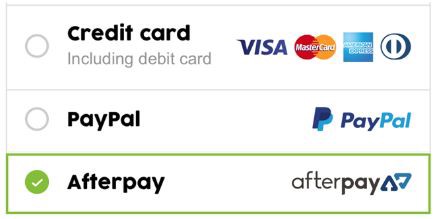Afterpay’s competitive differentiation underpins a sustainable business model that we expect will continue to drive its market share growth in the US. Visa’s recent announcement will not impact Afterpay’s niche market segment as its unique value proposition to consumers and merchants means its business model will continue to thrive. Afterpay’s platform generates incremental sales for retailers while providing a simple and free solution for consumers, and Visa Next may strengthen the investment case over the long-term.
Last week, Visa announced the pilot of an instalment payment capability on the Visa Next platform. Launching in 2020 it will introduce additional flexibility to its global interchange network, allowing Visa card issuers — such as Banks — to more easily create instalment payment plans as part of their own debit and credit card services for customers.
This article discusses Visa Next, how it will make it easier for banks to differentiate their credit services, and how Afterpay’s competitive position prevents this from being a risk going forward. Finally, we discuss why we believe Visa Next could, in fact, improve Afterpay’s profitability in the long-term.
What Is Visa Next?
Visa is an interchange network that connects financial institutions globally, facilitating the transfer of electronic funds. Visa does not issue credit or debit cards directly to consumers, instead, banks, credit unions and even retailers issue branded Visa cards to their customers.
This issuing institution (‘card issuer’), such as a bank, owns the relationship with the customer and creates its own debit or credit card product with unique terms and conditions (i.e., payment terms, interest rates) and utilises its own credit facilities. The card issuer then leverages Visa’s global interchange network to send money between financial institutions. When your debit or credit card says ‘Visa’ on it, you don’t have a relationship with Visa, your bank is advertising that they do.
Visa Next is digital infrastructure which aims to enable banks to offer innovative new payment experiences on their debit and credit products. For example, one of the many features being explored on Visa Next will enable issuing cardholders to:

Visa itself is not entering the business of establishing direct relationships with customers, and it is not extending credit to any financial institution or customer. Visa is simply improving its infrastructure to make it easier for card issuers to differentiate their services.
Opportunity For Banks To Differentiate
Instalment capability in bank credit services is not new, however, Visa Next is looking to make it easier for banks to differentiate their credit services in an attempt to attract new customers — the instalment payment capability will be just one of many new possible features.
Instalment products, however, present a classic incumbent dilemma for US banks. Credit cards are often the most profitable operation of all banking activities. Instalment lending may be appealing to customers, but without high interest charges, would be cannibalistic to the profitability of existing consumer credit offers.
An instalment product can generate a return by charging the consumer, the merchant, or both. For a bank to build an instalment plan which charges merchants, it would be required to contract with merchants individually. It is unlikely that a bank would pursue such an undertaking, and if they did we would not expect a single issuer to provide the insights and analytics that Afterpay currently offer merchants.
The bank would more likely create an instalment product that attempts to improve on the traditional credit experience, allowing consumers to select a flexible repayment term with a capped interest rate or fixed charges such as ‘account fees’. Effectively, credit cards could more easily be turned into flexible digital wallets similar to offerings like ZipMoney in Australia and Affirm in the US.
Rather than build ‘instalment cards’, we believe the more likely outcome will be that banks will add instalments as a feature to their traditional credit card facilities on qualifying purchases. For example, JPMorgan Chase recently launched a similar feature on its credit card where customers can select from past purchases over $500 and elect to finance them over longer periods with monthly fees, rather than interest-based repayments.
We believe banks will use these features to differentiate and allow consumers to personalise the credit repayment experience for ‘qualifying purchases’. This appears consistent with the Visa press release: “With Visa’s instalment solutions, Visa cardholders will have the option to divide their total purchase amount into smaller, equal payments over a defined time period on qualifying purchases at the store and online or while travelling abroad” [1].
Instalment Products: Popular In Brazil, But Elsewhere?
Visa highlights the significance of instalments in Brazil, referring to it as an ‘early adopter’ with 50% of credit payment volumes in instalments. It would be incorrect, however, to infer from the Brazilian case study that the availability of Visa Next’s infrastructure would transform consumer credit in new markets.
Instalments are a core part of Brazilian payment culture due to a history of high inflation, exorbitantly high interest rates and low real incomes. Retailers invented private instalment options in the 1970s to help consumers meet spend aspirations before the credit card market was widely available decades later.
The popularity of retailer-led instalment products in Brazil was driven by economic conditions and a lack of centralised credit alternatives (i.e., credit cards), rather than available interchange technology. The technology later developed to meet these cultural norms that exist today. Banks facilitate these instalment plans by making the functionality a feature of a traditional credit card, whereby purchase values are deducted from the consumer’s credit card limit.
In Brazil, products are advertised as ‘interest free’, however, the finance cost charged by the retailer is embedded in the instalment purchase plan. Customers pay upfront to receive a discounted price. Banks often do not take the instalment credit risk, and instead charge their customer on each instalment date, before passing each payment to the retailer 30 days in arrears.
No doubt consumer-pays instalment card products are popular in Brazil, but they have failed to gain traction elsewhere globally. For example, in 2016, MasterCard launched ‘MasterCard Instalments’ in Europe — a product equivalent to Visa Next instalments — off the back of consumer research that indicated consumers wanted more “flexible payment solutions to fulfil their needs while maintaining better control over their budget” [2]. Since this launch, there has been some evidence of modest success in Romania, but limited evidence of traction in other geographies.
This brings us back to Afterpay’s competitive position which will allow it to grow in this market segment, despite the optics that ‘it’s another instalment product’.
Afterpay Is More Than Just POS Instalment Credit
In the future, digital wallets and credit offers will contain significantly more flexibility, with non-standardised solutions from different banks and lenders. But is this a threat to Afterpay’s business model?
Afterpay’s success has been built on the value it drives to merchants from its millions of engaged customers. In return, merchants value Afterpay as a retail channel, paying 3–6% on each transaction with terms and conditions that prohibit the fee being passed on to the customer. With an average receivables duration of less than 30 days, this becomes a highly profitable business model, allowing Afterpay to keep the service free for consumers who pay on time.
Afterpay has effectively flipped the traditional credit model on its head. This is a radically different way of building a credit business, requiring thousands of individual merchant contracts, and is unlikely something banks would individually seek to replicate.
Afterpay has created a standardised instalment product with a fundamentally different way of pre-screening customers for credit risk. By not utilising traditional credit scores, it gives consumers an opportunity to ‘earn’ a credit limit over time. Its unique management of bad debts via their dynamic credit allowance that grows with good behaviour and shuts off if consumers are behind in repayments, is superior to a bank’s traditional one-off ‘credit limit’ approval which does not dynamically take into account the ongoing appropriateness of the limit.
If a consumer cannot repay for whatever reason, their credit score is untarnished as Afterpay does not report to the credit bureau. The mere existence of the US$40 billion payday lending market in the US is indicative of the banking industry’s lack of innovative credit models to better assess consumer risk and serve parts of these markets.
We believe the risk posed to Afterpay’s business model is low.
A Longer-term Opportunity For Afterpay
Customers use Afterpay as a ‘free and simple’ credit budgeting tool, which extends its reach beyond eCommerce POS to bricks and mortar retail. The development of Visa Next could prove positive for Afterpay’s longer-term opportunity for in-store purchases.
Every time a customer makes an instalment to Afterpay, a large ‘interchange expense’ is shared between the customer’s bank (as the card issuer), the interchange network (Visa or MasterCard), and Afterpay’s bank (‘acquiring bank’).
Our understanding is that typically, 60% of the interchange fee is kept by the customer’s bank, and the remainder is shared between the interchange network and the acquiring bank. The customer’s bank keeps 60% of the economics because it owns the customer relationship. This transaction revenue is what affords banks to run rewards credit card schemes.
Afterpay is highly valued by its millions of customers, as evidenced by its high Net Promoter Score. Longer-term, Afterpay may leverage these customer relationships, potentially establishing itself as a card issuer in partnership with a financial institution, similar to Amazon’s card partnership with JPMorgan Chase, or Apple’s partnership with Goldman Sachs. To be clear, we do not believe Afterpay would launch a debit or traditional credit card, but instead an ‘instalment card’ enabled by Visa Next’s infrastructure.
In theory, an instalment-type card would make the Afterpay service accessible at POS terminals without the need for the current in-store integration program, accelerating opportunities for Afterpay customers to utilise its service in-store and bringing more incremental sales to merchants. Furthermore, Afterpay would also be able to negotiate a share of the 60% of interchange currently kept by the card issuer, improving its unit economics on one of its largest cost lines, particularly in the US market.
A Final Thought
PayPal (and its US$135 billion market cap) exists despite the presence of debit and credit cards because it brings something else to the table at eCommerce POS checkout: convenience and trust. Afterpay exists because it brings something different to the credit offer: a ‘simple and free’ budgeting tool that delivers significant value to merchants.
In the world of eCommerce POS, we believe Afterpays market positioning from a customer and merchant perspective will continue to deliver value for both these stakeholders. Their value proposition is demonstrated by retailers’ willingness to provide Afterpay with prime POS real estate. We expect continued long-term growth to be delivered by this Quality Franchise, and keenly await the opportunities presented by Visa Next.

Sources: [1] Visa press release [2] MasterCard press release
The article has been prepared by ECP Asset Management Pty Ltd (ECP). ECP is a funds management firm based in Sydney, Australia. For further information visit www.ecpam.com. This material has been prepared for informational purposes only, and is not intended to provide, and should not be relied on for financial advice. ECP and the analyst own shares in Afterpay Touch Group Ltd. ABN 26 158 827 582, AFSL 421704, CAR 44198.



